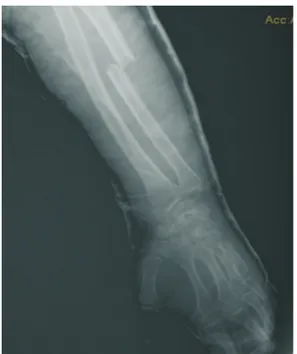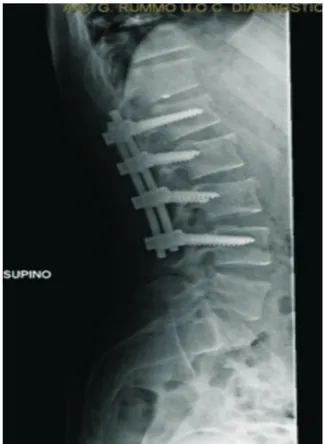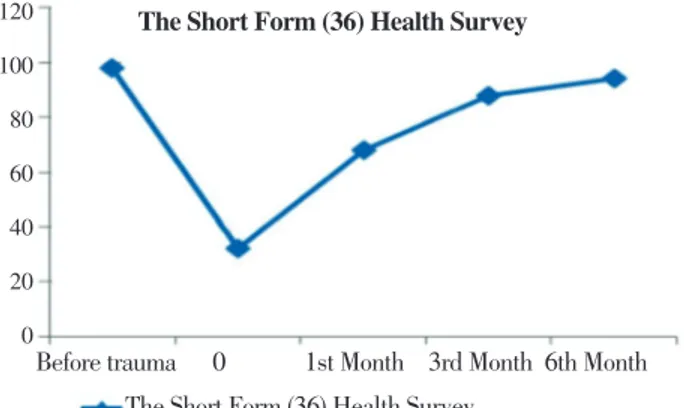Document heading doi: 10.1016/S2221-6189(14)60089-5
Is the early percutaneous spine total care to treat the polytrauma patient
a good way?
Gabriele Falzarano
1, Antonio Medici
1, Giuseppe Pica
1, Predrag Grubor
2, Milan Grubor
2, Francesco
Vitaliano Muziì
3, Mirza Biscevic
4, Arianna Falzarano
5, Luigi Meccariello
6*1U.O.C. Orthopedics and Traumatology , AO G.Rummo, Benevento, Italy
2Orthopaedics and Traumatology Clinic Banja Luka, Republic of Srpska, Bosnia and Herzegovina
3Department of Medical and Surgical Sciences and Neuroscience, Section of Neurosurgery, University of Siena, University Hospital “Santa Maria alle Scotte”,
Siena, Italy
4Orthopaedics and Traumatology Clinic Sarajevo, Sarajevo, Bosnia and Herzegovina 5Faculty of Medicine, Vasile Goldiș Western University of Arad, Arad, Romania
6Department of Medical and Surgical Sciences and Neuroscience, Section of Orthopedics and Traumatology, University of Siena, University Hospital “Santa
Maria alle Scotte”, Siena, Italy
ARTICLE INFO ABSTRACT
Article history: Received in 20 Jan 2015
Received in revised form 21 Jan 2015 Accepted 23 Jan 2015
Available online 26 Jan 2015 Keywords:
Spine fractures Polytrauma Early total care Floating knee Damage control
*Corresponding author: Luigi Meccariello, MD, Department of Medical and Surgical Sciences, and Neuroscience, Section of Orthopedics and Traumatology, University of Siena, University Hospital “Santa Maria alle Scotte”, Viale Bracci 1, 53100 Siena, Italy.
E-mail: [email protected] Tel: +39 329 9419574
1. Introduction
Decision making and communication are vital factors for successful surgery; good surgeons make wise decisions. Before recommending surgical treatment, a thorough assessment of the patient must be undertaken to understand the full extent of the injury, anticipate
and prevent postoperative complications, and determine the potential for recovery. In our setting, the concept of damage control surgery entails a three-phase approach to the surgical management of the trauma patient. In the initial phase, the prime aim is to establish rapid control of hemorrhage and to identify and control major injuries[1]. The next step is to stabilize major fracture(s), to reduce
dislocated joint(s) and to decontaminate open wound(s)
with appropriate surgical methods, which may or may not be definitive[1]. Once normal physiology has been restored,
a final phase entails definitive injury repairs[1].
The “ideal” timing and modality of fracture fixation for unstable thoracolumbar spine fractures in multiply
The "ideal" timing and modality of fracture fixation for unstable thoracolumbar spine fractures in multiply injured patients remains controversial. The concept of "damage control orthopedics" is expressed. We presented a case report of a 27 years' old male who sustained a multilevel spine fractures associated a floating knee (Fraser’s Type A), ulna fracture and carpal scaphoid fracture
in July 2014 after car accident (very high energy trauma). All these fractures were treated in early total care. We reported a case control to discuss about the early spinal total care associated at orthopedic total care in patients with multiple trauma.
Contents lists available at ScienceDirect
Journal of Acute Disease
injured patients remains controversial. The concept of “damage control orthopedics”, which has evolved globally in the past decade, provides a safe guidance for temporary external fixation of long bone or pelvic fractures in multisystem trauma[2]. In contrast, “damage
control” concepts for unstable spine injuries have not been widely implemented, and the scarce literature in the field remains largely anecdotal[2]. The current practice
standards are reflected by two distinct positions, either immediate “early total care” or delayed spine fixation after recovery from associated injuries. Both concepts have inherent risks which may contribute to adverse outcome[2].
2. Case presentation
We presented a case report of a 27 years’ old male with a history of drug addiction and alcoholism, after car accident in July 2014 (very high energy trauma). He sustained a multilevel thoraco-lumbar spinal associated a right floating knee (Fraser’s Type A), left ulnar shaft
fracture and left carpal scaphoid fracture. At admission in emergency room, the Glasgow Coma Score was 13 and Injury Severity Score was 22. The vertebral body spine fractures were at L1 (Type A3 according Magerl’s classification) and L2 (Type A2 according Magerl’s classification)(Figure 1). The right floating knee (Fraser’s Type A), femoral shaft and tibial shaft in ipsilateral
leg were shown in Figure 2. The fractures on left arm, not dominance were ulnar shaft fracture and carpal scaphoid fracture (Figure 3). All these fractures were treated in early total care. Spine fractures were treated by percutaneous short posterior stabilization with undersize pedicle screws in fractured vertebra’s body (Figure 4).
The right floating knee (Fraser’s Type A) was treated by
femoral intramedullary nailing and tibial intramedullary nailing (Figure 5). The ulnar shaft fracture was treated by open reduction internal fixation with plate and wires
(Figure 6). The carpal scaphoid fracture was treated by percutaneous screw. A plaster cast arm-forearm-metacarpal was applied at his left upper limb. The surgical time to treat all fractures was 327 min, 423 min of the anesthetic. The patient after surgery was hospitalized in intensive care for one day. It has not been subjected to blood transfusions, but made the common antibiotic prophylaxis and enoxaparin 4000 IU1 fl/day under the
skin. He hospitalized in the physiotherapy department for the first day and was verticalized in the second post-operative day. The patient was not subjected to any blood transfusion during hospitalization and lost only 3 points hemoglobin. The follow-up programs consisted of radiographic control of injures segments, VAS (Figure 7),
Oswestry low back pain disability questionnaire (OLBPSQ)
used to quantify disability for low back pain (Figure 8)
and The Short Form (36)Health Survey(SF-36) at 1 month, 3 months and 6 months (Figure 9). He had no complication during the follow up.
Figure 1. CT showed the instability of the fractured in L1 instead of the fracture stability of L2.
Figure 2. The CT’s scout showed the femoral shaft fracture and XR showed the tibial shaft fracture.
Figure 4. Treatment of spine fractures by percutaneous short posterior stabilization with undersize peduncolar screws in fractured vertebral body.
Figure 5. The right floating knee (Fraser’s Type A) was treated by femoral intramedullary nailing and tibial intramedullary nailing.
Figure 6. Ulnar shaft fracture’s treatment by ORIF with plate and wires; single screw for the treatment of carpal scaphoid fracture.
9 8 7 6 5 4 3 2 1 0
Before trauma 0 1st Month 3rd Month 6th Month VAS
VAS
Figure 7. Trend of back pain during the 6 months of follow up measured with VAS.
100 90 80 70 60 50 40 30 20 10 0
Before trauma 0 1st Month lllrd Month VIth Month OLBPSQ
OLBPSQ
Figure 8. Trend of back quality life during the 6 months of follow up measured with OLBPSQ.
120 100 80 60 40 20 0
Before trauma 0 1st Month 3rd Month 6th Month The Short Form (36) Health Survey
The Short Form (36) Health Survey
Figure 9. Trend of quality life during the 6 months of follow up measured with SF-36.
3. Discussion
Polytrauma patients have a severely deranged immune response, characterized by an early excessive activation of innate immunity (hyperinflammation), followed by a
delayed attenuation of adaptive immunity with decreased T-cell function (immunosuppression) and enhanced
susceptibility to infection, sepsis, and multiple organ failure[3,4]. In addition, about a third of all multiply injured
patients have severe disturbances of their clotting system on arrival to the emergency department, as determined by the presence of post injury coagulopathy[5,6]. Early
total care is beneficial for some patients with polytrauma. This involves definitive surgical stabilization of all long-bone fractures during the early phase of treatment. This may reduce pulmonary complications and allow earlier rehabilitation of the patient[7-10].
Early total care is suitable for patients with multiple fractures but without major chest or visceral injury. Patients must be hemodynamically stable with normal blood gases, clotting, and temperature.
The concept of “spine damage control” will provide a safe and effective treatment modality for unstable thoraco-lumbar fractures in multiply injured patients, associated with less complications and improved outcomes compared to conventional treatment strategies. In 2005, Stahel et al. and Heyde et al. have defined “spine damage control” as a staged procedure of immediate posterior fracture reduction and instrumentation within 24 h (“Day 1 surgery”)[11,12]. This concept differs from
the more common elective strategy of a staged spine fixation by initial posterior fixation and delayed anterior completion by its timeliness (posterior fixation within 24 h) and expanded applicability to all unstable
thoraco-lumbar fractures, including pure anterior column burst fractures (AO/OTA type A3)[2].
Decision-making regarding non-operative versus operative treatment of patients with thoraco-lumbar Magerl’s Type A fractures in the absence of neurologic deficits is controversial. Lack of evidence-based practice may result in patients being treated inappropriately and being exposed to unnecessary adverse consequences. With respect to the patients’ status after treatment of a spinal fracture, literature mostly focuses on radiological aspects[13]. The study of Post et al. was developed to gain
insight into the functional outcome in patients treated non-operatively for a thoraco-lumbar spinal fracture[13]. What is it really advantageous for a good alignment of the spine in young adult? In 2014, Medici, Meccariello and Falzarano reported 39 adult patients with thoraco-lumbar spinal fractures according to Magerl’s A1 and A2; 24 patients were treated with 3 points orthopedic corset and 15 patients were treated with percutaneous posterior stabilization without augmentation[14]. Although
the data are preliminary and based on data available in the literature, we can say that the percutaneous posterior stabilization of thoraco-lumbar fractures lumbar in Magerl’s A1 and A2 in the adults is the ideal method for a good and functional alignment of the spine[14]. The
advantages of percutaneous posterior stabilization were faster than open posterior stabilization, reduced the back pain, improved the quality life, small blood loss average 3 gauze (range 1-6); the exposure of surgeons to
ionizing radiation was less than 1 millisievert for each stabilization; the reduction of hospitalization days and reduction of the miscellaneous complications[14]. Fracture
level screw combination provided better intraoperative correction and maintenance in the treatment of unstable thoraco-lumbar burst fractures, which was more prevalent in short-segment fixation group. Reinforcement with fracture level screw combination can help to provide better kyphosis correction and offers immediate spinal stability in patients with thoraco-lumbar burst fracture[14,15]. An interestingly and encompassing
prospective multicenter study published in the German literature by the spine working group of the German Trauma Society (“Arbeitsgemeinschaft Wirbelsaeule der Deutschen Gesellschaft fuer Unfallchirurgie”)
revealed that 65.7% of all polytrauma patients with
operative thoraco-lumbar fractures (n=682) are currently
treated by exclusive posterior fixation in German and Austrian level 1 trauma centers[16]. The authors showed
that posterior instrumentation was associated with a decreased complication rate of 4.7%, compared to 10.8%
only 0.4% of all patients with posterior instrumentation
showed a secondary neurological deterioration, implying that the “spine damage control” procedure is safe from a neurological perspective[16].
4. Conclusion
The early spinal total care is still a main topic of spinal surgery and the management of patients with multiple trauma. In selected patients with multiple trauma, percutaneous posterior stabilization of the thoraco-lumbar spine remains a viable choice for the early spinal total care.
Conflict of interest statement
The authors report no conflict of interest.
Acknowledgments
Patient was treated according to the Helsinki Declaration’s ethical standards, and he was asked if he could read and understand the patient information sheet and sign the informed consent form. None of the authors had received direct or indirect compensation for the realization of this paper.
References
[1] Kossmann T, Trease L, Freedman I, Malham G. Damage control surgery for spine trauma. Injury 2004; 35(7): 661-670.
[2] Stahel PF, Flierl MA, Moore EE, Smith WR, Beauchamp KM, Dwyer A. Advocating “spine damage control” as a safe and effective treatment modality for unstable thoracolumbarfractures in polytrauma patients: a hypothesis. J Trauma Manag Outcomes 2009; 3: 6.
[3] Pape HC, Rixen D, Morley J, Husebye EE, Mueller M, Dumont C, et al. Impact of the method of initial stabilization for femoral shaft fractures in patients with multiple injuries at risk for complications (borderline patients). Ann Surg 2007; 246: 491-499.
[4] Morshed S, Miclau T 3rd, Bembom O, Cohen M, Knudson MM, Colford JM Jr. Delayed internal fixation of femoral shaft fracture reduces mortality among patients with multisystem trauma. J Bone Joint Surg (Am) 2009; 91: 3-13.
[5] MacLeod JB, Lynn M, McKenney MG, Cohn SM, Murtha M. Early coagulopathy predicts mortality in trauma. J Trauma 2003; 55: 39-44.
[6] Maegele M, Lefering R, Yucel N, Tjardes T, Rixen D, Paffrath T, et al. Early coagulopathy in multiple injury: an analysis from the German Trauma Registry on 8724 patients. Injury 2007; 38: 298-304.
[7] Pape HC, Grimme K, Van Griensven M, Sott AH, Giannoudis P, Morley J, et al. Impact of intramedullary instrumentation versus damage control for femoral fractures on immunoinflammatory parameters: prospective randomized analysis by the EPOFF Study Group. J Trauma 2003; 55(1): 7-13.
[8] Grubor P, Grubor M, Falzarano G, Medici A, Meccariello L. Importance of eternal fixation in primary treatment of war wounds. Acta Facultatis Medicae Naissensis 2011; 28: 225-233.
[9] Grubor P, Falzarano G, Medici A, Grubor M, Franzese F, Errico G, et al. The damage control orthopedics and external fixation in traffic accident after 20 years in the Bosnian War: our experience and a review of the literature. SYLWANJ 2014; 158(6): 90-109.
[10] Meccariello L, Medici A, Fazarano G, Roberto VL, Errico G, Franzese R, et al. The intramedullary nailing in femoral and tibial open fractures: A Review of Literature. Canadian Open Orthopaedics Traumatol J 2014; 1: 8-12.
[11] Stahel PF, Heyde CE, Wyrwich W, Ertel W. [Current concepts of polytrauma management: from ATLS to “damage control”]. Orthopade 2005; 34: 823-836. German.
[12] Heyde CE, Ertel W, Kayser R. ]Management of spine injuries in polytraumatized patients]. Orthopade 2005; 34: 889-905. German.
[13] Post RB, Keizer HJ, Leferink VJ, van der Sluis CK. Functional outcome 5 years after non-operative treatment of type A spinal fractures. Eur Spine J 2006; 15(4): 472-478. [14] Medici A, Meccariello L, Falzarano G. Non-operative
vs. percutaneous stabilization in Magerl’s A1 or A2 thoracolumbar spine fracture in adults: is it really advantageous for a good alignment of the spine? Preliminary data from a prospective study. Eur Spine J 2014; 23: 677-683.
[15] Guven O, Kocaoglu B, Bezer M, Aydin N, Nalbantoglu U. The use of screw at the fracture level in the treatment of thoracolumbar burst fractures. J Spinal Disord Tech 2009; 22(6): 417-421.
[16] Knop C, Blauth M, Buhren V, Hax PM, Kinzl L, Mutschler W, et al. Operative treatment of thoracolumbar fractures. Part II: Operation and radiology. Unfallchirurg 2000; 103: 1032-1047.


